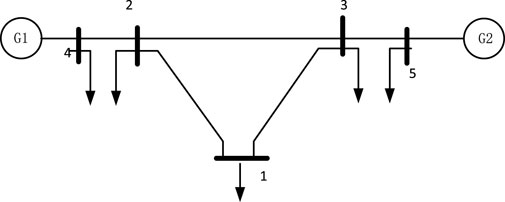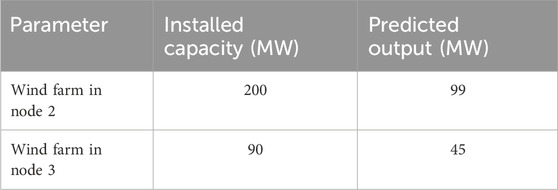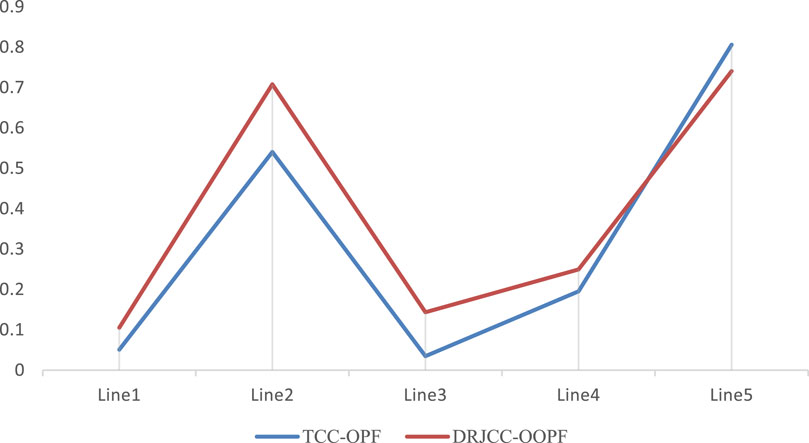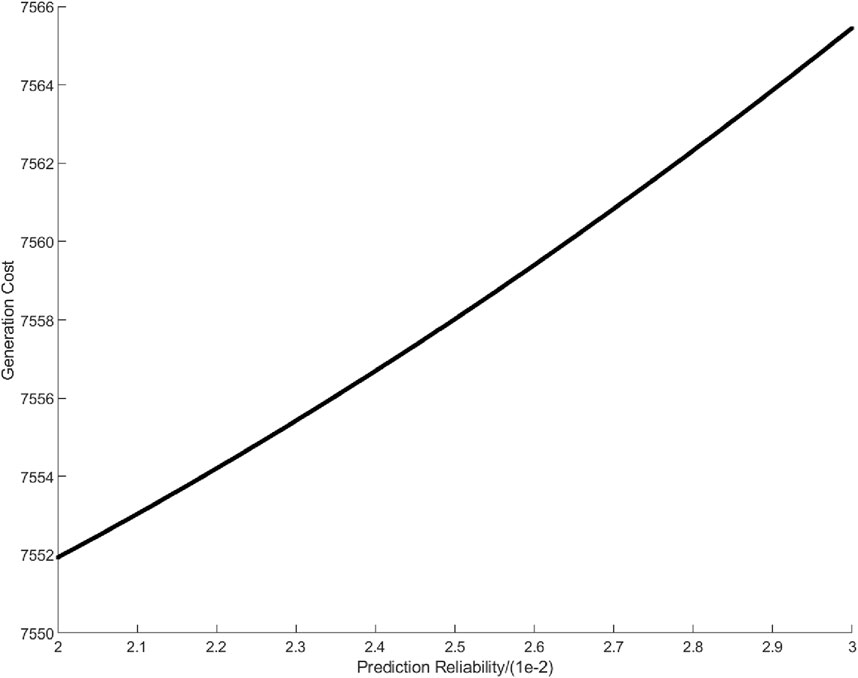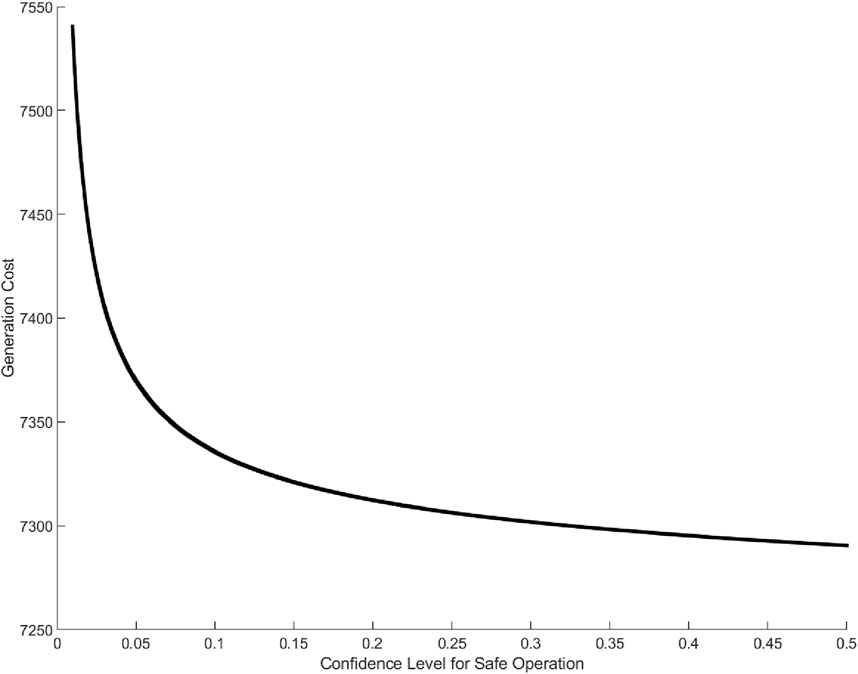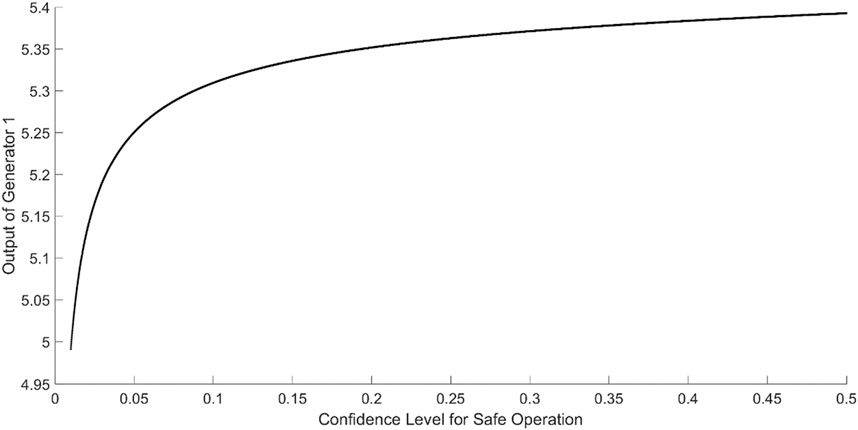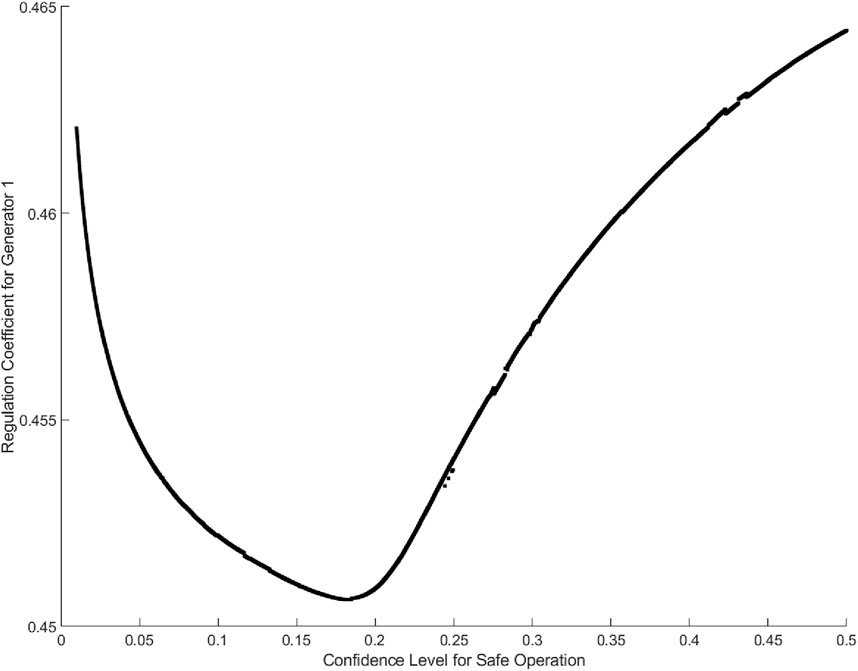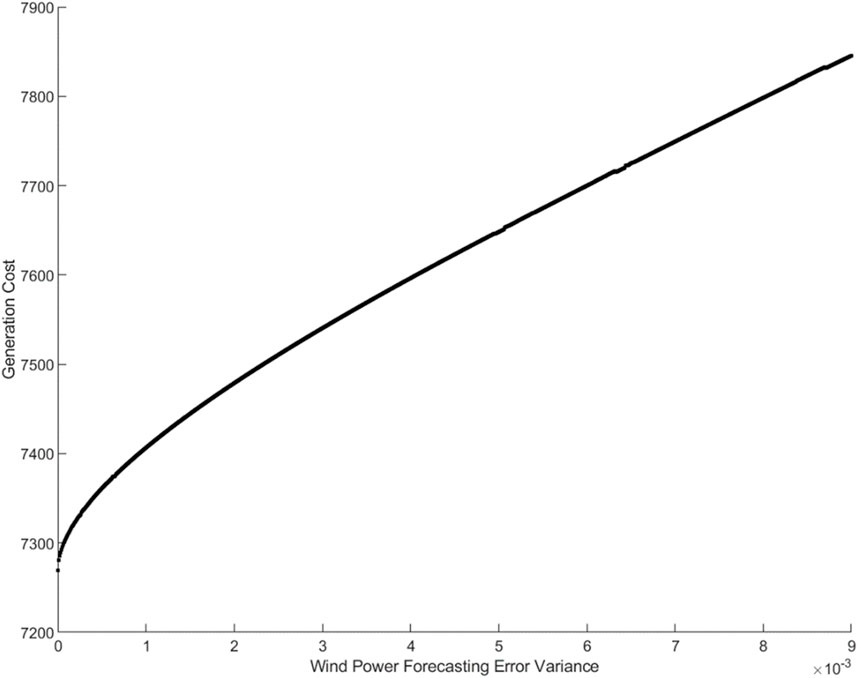Robust optimal power flow considering uncertainty in wind power probability distribution
- 1Guangzhou Power Supply Co. Ltd., China Southern Power Grid, Guangzhou, China
- 2School of Electric Power Engineering, South China University of Technology, Guangzhou, China
This paper proposes an optimal power flow model that takes into account the uncertainty in the probability distribution of wind power. The model can schedule controllable generators under any possible distribution of wind power to ensure the safe and economic operation of the system. Firstly, considering the incompleteness of historical wind power data, the paper models the uncertainty of wind power using second-order moments of probability distribution and their fluctuation intervals. Subsequently, a robust optimal power flow model based on probability distribution model and joint chance constraints is established. The Lagrangian duality theorem is then employed to eliminate random variables from the optimization model, transforming the uncertainty model into a deterministic linear matrix inequality problem. Finally, a convex optimization algorithm is used to solve the deterministic problem, and the results are compared with traditional chance-constrained optimal power flow model. The feasibility and effectiveness of the proposed method are validated through case study simulations.
1 Introduction
As the penetration rate of intermittent renewable energy sources, such as wind and solar power, continues to rise, the shortcomings of existing operating modes in the power system may limit the integration of new energy sources. The intermittency and incomplete controllability of renewable energy generation pose significant challenges to the safe and economic operation of the power system.
Traditional power systems mainly rely on thermal power generation to meet electricity demand, with no renewable energy generation units in the system. Therefore, traditional optimal power flow models proposed in (Bacher and Van Meeteren, 1988; Hua et al., 1998; Zhang et al., 2020; Kardoš et al., 2022) are not suitable for scenarios considering the uncertainty of new energy output. With the gradual development of low-carbon power construction, the significant injection of new energy has huge impacts on the safe and economic operation of the power system, demanding a reform in the power system’s operational control mode. The volatility of wind power output (Ela and O'Malley, 2012) can be addressed at the planning level by configuring energy storage to smooth out output fluctuations (Wang et al., 2013; Angizeh et al., 2023; Fan et al., 2023). On the operational level, controllable generators can be scheduled to absorb fluctuations. In recent years, research on optimal power flow problems considering the stochastic nature of wind power has attracted considerable attention (Morales and Perez-Ruiz, 2007; Bienstock et al., 2012; Shi et al., 2012; Li et al., 2015; Gao et al., 2017; Sun et al., 2019; Angizeh et al., 2023; Xiao et al., 2024a; Xiao et al., 2024b).
Reference (Li et al., 2015) establishes an optimal power flow model considering wind power uncertainty using stochastic programming. The paper obtains an estimated distribution of wind power output based on observed samples and generates a discrete scenario set based on this estimated distribution. However, the accuracy of the results depends on the number of observed samples and discrete scenarios, which can lead to the “curse of dimensionality.” Reference (Morales and Perez-Ruiz, 2007) proposes a probability optimal power flow algorithm based on three-point estimation, but the computational complexity of point estimation algorithms is high. Additionally, probabilistic power flow analysis should consider the correlation between realistically existing injection amounts, or it may result in significant errors (Sun et al., 2019). Reference (Bienstock et al., 2012) introduces the chance-constrained OPF (CC-OPF) model and proposes a cut-plane algorithm for solving it, assuming that wind power forecast errors follow a Gaussian distribution. To address the issue of modeling wind power stochastic errors with a single deterministic distribution, Reference (Gao et al., 2017) innovatively proposes the robust chance-constrained OPF (RCC-OPF) model, describing wind power forecast errors as random variables with uncertainty in both variance and expectation. However, Reference (Gao et al., 2017) does not provide a model-solving algorithm.
Against this background, this paper proposes a power system optimal power flow calculation method considering the uncertainty of wind power probability distribution. The paper first models the uncertainty of wind power output using partial statistical information (Bofinger et al.). It then describes the optimal power flow problem of a wind farm system with distributionally robust joint chance constraints (DRJCC-OPF) (Zymler et al., 2013; Bian et al., 2014) and employs the Lagrangian duality to eliminate random variables in the model (Ding, 2014), transforming the uncertainty model into a deterministic linear matrix inequality (LMI). Furthermore, convex optimization methods are used to solve the deterministic LMI. This approach, based on partial statistical information of wind power in the power system, innovatively considers the uncertainty of the probability distribution of wind power forecast errors, obtaining generation scheduling plans that can meet the requirements of safe and economic operation of the power system under arbitrary wind power distributions. The feasibility and effectiveness of the method are verified through an IEEE 5-node case study.
2 Traditional chance-constrained optimal flow model
Deterministic optimal power generation scheduling results are based on renewable energy output forecasts and do not take into account fluctuations in new energy output, which often results in frequent line overloads and power system security risks (Zhang et al., 2018). Traditional chance-constrained optimal flow model (traditional-chance-constrained TCC-OPF) can correct this problem and buffer critical renewable energy fluctuations to ensure secure and economic operation of the power system (Ma et al., 2019)
Where:
Equation 2 and 4 are nodal power balance equation and line flow equation; Eqs 3 and (6) and 7 are generation output limits of generators. Eqs 5, 10, 11 are the thermal limits of power lines. Eqs 8–9 are ramping limits of generators. The objective function is minimization of generation costs. TCC-OPF model ensures safe operation of the system at a given confidence level while minimizing power generation costs。
The TCC-OPF model is based on a single accurate probability distribution of wind power prediction errors, and is therefore only suitable for situations where a definite and comprehensive description of wind power or wind speed stochasticity exists.
3 Probabilistic distribution robust joint chance-constrained optimal power flow model and solution
Due to significant wind power fluctuations, we often can only obtain partial information about the probability distribution of wind power or wind power prediction errors (Bienstock et al., 2012). Without loss of generality, this paper assumes knowledge of the second-order moment information of the probability distribution of the wind power prediction error vector
Where, μ0 and Γ0 represents the empirical estimate of the second moment of wind power prediction errors; η denotes the extent of deviation between the actual second moment and its estimated value, reflecting the accuracy of wind power predictions.
Based on the above assumptions, this paper proposes a method of using a series of probability distribution functions that satisfy the given second moment information to describe the uncertainty of wind power prediction errors. Let the probability distribution set formed by the series of probability distribution functions be denoted as Ф(μw,Γ).
This section first establishes a robust joint chance-constrained optimal power flow model. Subsequently, the robust joint chance-constrained model is transformed into a deterministic Linear Matrix Inequality (LMI) problem, which does not involve random variables. Finally, a convex optimization algorithm is employed to solve this problem.
3.1 Probabilistic distribution robust joint chance-constrained optimal power flow model
In response to the uncertainty associated with the probability distribution of wind power prediction errors, and in order to obtain a generation scheduling scheme that satisfies system safety constraints under any probability distribution in Ф(μw,Γ). Based upon the TCC-OPF models, the DRJCC-OPF is employed to describe the optimal power flow problem considering wind power uncertainty. The specific model is as follows:
Where Eq. 16 represents the objective function, indicating the generation cost considering the regulating output of thermal power units (the specific transformation process of the objective function is detailed in the appendix); var(Ω) represents the variance of Ω. ε denotes the confidence level of violating the robust joint chance constraints;
In the above model, the probability distribution of wind power prediction errors is uncertain and can take any form of probability distribution in
The decision variables of the DRJCC-OPF model are represented by
Eqs 17–20, 22, 23 are deterministic constraints, while Eq. 21 represents the uncertainty constraint. The challenge in solving the DRJCC-OPF model lies in handling the probability distribution robust joint chance constraint equation.
3.2 Deterministic transformation of probability distribution robust joint chance constraints
Express the constraints in Eq. 21 in the form of unilateral constraints and separate the decision variables from the random variables, as shown below:
For line power flow
Where eT is the unit vector with all elements equals to 1. After replacing the expression in Eq. 21 with Eqs 25–30, the result is:
Furthermore, by eliminating the random variables in Eq. 31 and transforming it into a deterministic problem (the detailed proof process is provided in the appendix), the resulting deterministic problem corresponding to the DRJCC-OPF model is expressed as follows:
Where
3.3 Solution algorithm
Eq. 32 represents a convex optimization problem with LMI constraints, and a convex optimization algorithm can be employed to obtain the global optimal solution.
4 Case study
This paper conducts simulation tests using a modified 5-node system as shown in the diagram. The power system topology is illustrated in Figure 1, and specific data can be found in reference (Wang, 2003). Nodes 2 and 3 are connected to a wind farm, and the wind farm data is provided in Table 1. Optimization modeling is performed on the MATLAB platform, and the YALMIP solver is invoked to solve the LMIs in the model.
For simplicity in analysis, this paper assumes that the output of each wind farm is independent of each other. The expected value of wind power prediction error is denoted as
4.1 Comparison of simulation results between TCC-OPF and DRJCC-OPF
Let
According to Table 2, it is evident that the generation cost in DRJCC-OPF is higher than that in TCC-OPF. This is because DRJCC-OPF represents a more conservative estimate, ensuring system compliance with safety requirements under the worst-case distribution. Additionally, from Figure 2, it can be observed that under DRJCC-OPF, the absolute deviation of line power flow is higher than that under TCC-OPF. This indicates a more uniform distribution of line power flow, making it less prone to overloads.
4.2 Simulation results for robust joint chance-constrained OPF
This section analyzes the impact of system operating parameters and wind power uncertainty parameters on the system generation cost. The system operating parameters include the confidence level of safe operation, which is the probability
4.2.1 Impact of wind power prediction reliability on cost
Let
Figure 3 shows that as the prediction reliability decreases (or increases), the generation cost increases. This is because when the prediction accuracy decreases, the system needs to dispatch generators, especially Generator 2 with greater regulating capacity, to cope with the fluctuations in uncertain parameters, leading to an increase in generation cost.
4.2.2 Impact of system safety operation confidence level on generation cost
Let
Figure 4 indicates that with the relaxation of the system’s safety operation constraints, the generation cost decreases. In Figure 5, as the safety constraints increase, the controllable output of the generating units decreases to reserve more regulating capacity to cope with the fluctuations in wind power output. When the confidence level of violating chance constraints is greater than 0.1, the impact of safety constraints on the output of generating units is relatively small. This is because, in this case, the less strict system’s safety constraints demands less regulating capacity for the generating units. The generating units can operate under optimal conditions with lower impact. When the confidence level of violating chance constraints is less than 0.1, the safety constraints become more stringent, and further increasing the safety constraints significantly affects the output of generating units.
Moreover, combining Figures 5, 6, it can be observed that when
4.2.3 Impact of wind power output fluctuations on generation cost
Let
Figure 7 indicates that after an increase in wind power fluctuations, the system needs to increase the planned output of Generator 2 to maintain safe operation, leading to an increase in generation cost. Additionally, from Figure 8, it can be observed that considering wind power fluctuations, the system decreases the planned output of Generator 1 and increases the output of Generator 2 to enhance the system’s ability to cope with wind power fluctuations. At the same time, the regulation coefficient for Generator 1 rapidly decreases and then gradually increases. This is because when wind power fluctuations start to increase from zero, Generator 1 is constrained by the output limit, leading to a rapid decrease in its regulation coefficient. As Generator 1 deviates from the output limit due to a decrease in output, if wind power fluctuations continue to increase, the system gradually decreases the regulation coefficient for Generator 2 and increases the regulation coefficient for Generator 1 to reduce generation cost. This indicates that DRJCC-OPF can ensure safe and economic operation even when wind power fluctuations are significant.
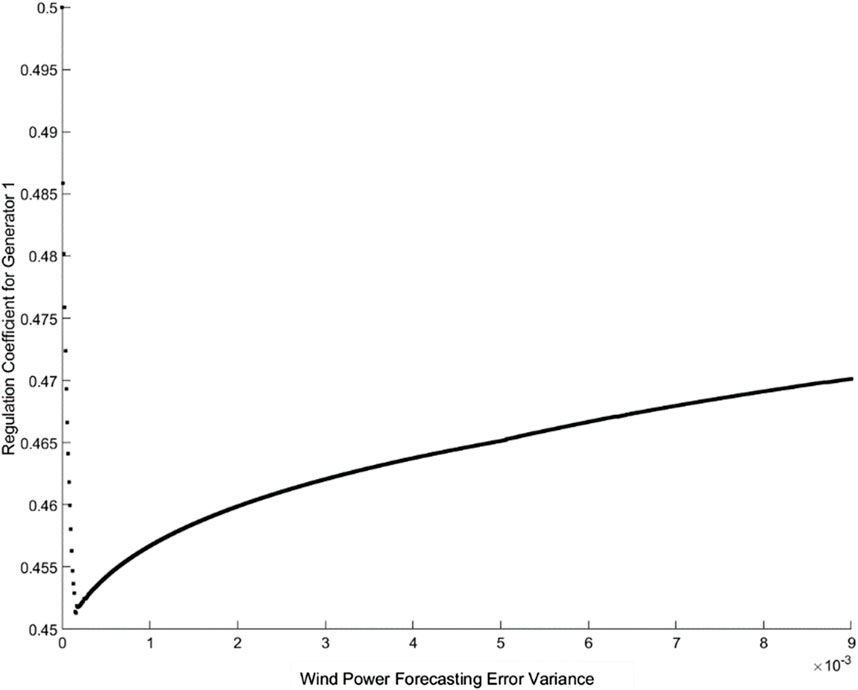
Figure 8. Graph of Regulation Coefficient for Generator 1 vs. Wind Power Forecasting Error Variance.
5 Conclusion
The large-scale integration of new energy sources, especially wind power, poses significant challenges to the secure operation of power systems. This paper focuses on the uncertainty in wind power prediction errors and proposes a probabilistic distribution robust joint chance-constrained optimal power flow model for wind power systems. This model can obtain scheduling schemes for thermal power units that ensure safe and economic operation under the worst-case wind power distribution. The analysis also explores the impact of factors such as prediction reliability, confidence level for safe system operation, and wind power fluctuations on system generation cost and unit dispatch strategies. This approach provides a new perspective for the economic dispatch of power systems incorporating renewable energy sources. The findings can serve as a reference for system operators and control personnel in managing power systems with renewable energy integration.
Data availability statement
The raw data supporting the conclusion of this article will be made available by the authors, without undue reservation.
Author contributions
LD: Investigation, Methodology, Writing–original draft. HX: Software, Validation, Writing–review and editing. PY: Data curation, Resources, Supervision, Writing–review and editing.
Funding
The author(s) declare that financial support was received for the research, authorship, and/or publication of this article. This work was supported by Guangdong Basic and Applied Basic Research Foundation under Grant 2024A1515011537.
Conflict of interest
Author LD was employed by Guangzhou Power Supply Co. Ltd.
The remaining authors declare that the research was conducted in the absence of any commercial or financial relationships that could be construed as a potential conflict of interest.
Publisher’s note
All claims expressed in this article are solely those of the authors and do not necessarily represent those of their affiliated organizations, or those of the publisher, the editors and the reviewers. Any product that may be evaluated in this article, or claim that may be made by its manufacturer, is not guaranteed or endorsed by the publisher.
References
Angizeh, F., Bae, J., Chen, J., Klebnikov, A., and Jafari, M. A. (2023). Impact assessment framework for grid integration of energy storage systems and renewable energy sources toward clean energy transition. IEEE Access 11, 134995–135005. doi:10.1109/ACCESS.2023.3337133
Bacher, R., and Van Meeteren, H. P. (1988). Real-time optimal power flow in automatic generation control. IEEE Trans. Power Syst. 3, 1518–1529. doi:10.1109/59.192961
Baharvandi, A., Aghaei, J., Niknam, T., Shafie-Khah, M., Godina, R., and Catalão, J. P. S. (2018). Bundled generation and transmission planning under demand and wind generation uncertainty based on a combination of robust and stochastic optimization. IEEE Trans. Sustain. Energy 9, 1477–1486. doi:10.1109/TSTE.2018.2789398
Bian, Q. (2015). Transmission system planning considering uncertainty of wind power probability distribution. Power Syst. Autom. 20. doi:10.7500/AEPS20141029009
Bian, Q., Xin, H., Wang, Z., Gan, D., and Wong, K. P. (2014). Distributionally robust solution to the reserve scheduling problem with partial information of wind power. IEEE Trans. Power Syst. 30, 2822–2823. doi:10.1109/TPWRS.2014.2364534
Bienstock, D., Chertkov, M., and Harnett, S. (2012). Chance constrained optimal power flow: risk-aware network control under uncertainty. Siam Rev. 56 (3), 461–495. doi:10.1137/130910312
Bofinger, S., Luig, A., and Beyer, H. G. “Qualification of wind power forecasts,” in Global Wind power Conference, Paris, France, 2002
Calafiore, G., Topcu, U., and El Ghaoui, L. (2009). Parameter estimation with expected and residual-at-risk criteria. Syst. Control Lett. 58, 39–46. doi:10.1016/j.sysconle.2008.07.007
Ding, K. (2014). Distributionally robust joint chance constrained problem under moment uncertainty. J. Appl. Math. 2014, 1–8. doi:10.1155/2014/487178
Ela, E., and O'Malley, M. (2012). Studying the variability and uncertainty impacts of variable generation at multiple timescales. IEEE Trans. Power Syst. 27, 1324–1333. doi:10.1109/TPWRS.2012.2185816
Fan, W., Tan, Q., Zhang, A., Ju, L., Wang, Y., Yin, Z., et al. (2023). A Bi-level optimization model of integrated energy system considering wind power uncertainty. Renew. Energy 202, 973–991. doi:10.1016/j.renene.2022.12.007
Gao, H., Liu, J., and Wang, L. (2017). Robust coordinated optimization of active and reactive power in active distribution systems. IEEE Trans. Smart Grid 9, 4436–4447. doi:10.1109/TSG.2017.2657782
Hua, W., Sasaki, H., Kubokawa, J., and Yokoyama, R. (1998). An interior point nonlinear programming for optimal power flow problems with a novel data structure. IEEE Trans. Power Syst. 13, 870–877. doi:10.1109/59.708745
Kardoš, J., Kourounis, D., Schenk, O., and Zimmerman, R. (2022). BELTISTOS: a robust interior point method for large-scale optimal power flow problems. Electr. Power Syst. Res. 212, 108613. doi:10.1016/j.epsr.2022.108613
Li, J., Lan, F., and Wei, H. (2015). A scenario optimal reduction method for wind power time series. IEEE Trans. Power Syst. 31, 1657–1658. doi:10.1109/TPWRS.2015.2412687
Ma, R., Li, X., Luo, Y., Wu, X., and Jiang, F. (2019). Multi-objective dynamic optimal power flow of wind integrated power systems considering demand response. CSEE J. Power Energy Syst. 5, 466–473. doi:10.17775/CSEEJPES.2017.00280
Morales, J. M., and Perez-Ruiz, J. (2007). Point estimate schemes to solve the probabilistic power flow. IEEE Trans. Power Syst. 22, 1594–1601. doi:10.1109/TPWRS.2007.907515
Shi, L., Wang, C., Yao, L., Ni, Y., and Bazargan, M. (2012). Optimal power flow solution incorporating wind power. IEEE Syst. J. 6, 233–241. doi:10.1109/JSYST.2011.2162896
Sun, W., Zamani, M., Zhang, H.-T., and Li, Y. (2019). Probabilistic optimal power flow with correlated wind power uncertainty via Markov chain quasi-monte-carlo sampling. IEEE Trans. Industrial Inf. 15, 6058–6069. doi:10.1109/TII.2019.2928054
Wang, C., Sun, W., Yi, T., Yan, Z., and Zhang, Y. (2013). Review on energy storage application planning and benefit evaluation methods in smart grid. Zhongguo Dianji Gongcheng Xuebao/Proceedings Chin. Soc. Electr. Eng. 33, 33–41.
Xiao, H., Gan, H., Yang, P., Li, L., and Hao, Q. (2024b). Robust submodule fault management in modular multilevel converters with nearest level modulation for uninterrupted power transmission. IEEE Trans. Power Deliv. 39, 931–946. doi:10.1109/TPWRD.2023.3343693
Xiao, H., He, H., Zhang, L., and Liu, T. (2024a). Adaptive grid-synchronization based grid-forming control for voltage source converters. IEEE Trans. Power Syst. 39, 4763–4766. doi:10.1109/TPWRS.2023.3338967
Zhang, C., Jian, J., and Yang, L. (2020). Regularised primal–dual interior-point method for dynamic optimal power flow with block-angular structures. IET Gener. Transm. Distrib. 14, 1694–1704. doi:10.1049/iet-gtd.2019.1528
Zhang, Y., Han, X., Xu, B., Wang, M., Ye, P., and Pei, Y. (2018). Risk–based admissibility analysis of wind power integration into power system with energy storage system. IEEE Access 6, 57400–57413. doi:10.1109/ACCESS.2018.2870736
Keywords: wind power uncertainty, fluctuation interval, robust joint chance constraints, convex optimization, optimal power flow
Citation: Dai L, Xiao H and Yang P (2024) Robust optimal power flow considering uncertainty in wind power probability distribution. Front. Energy Res. 12:1402155. doi: 10.3389/fenrg.2024.1402155
Received: 17 March 2024; Accepted: 11 April 2024;
Published: 08 May 2024.
Edited by:
Yi Cui, University of Southern Queensland, AustraliaCopyright © 2024 Dai, Xiao and Yang. This is an open-access article distributed under the terms of the Creative Commons Attribution License (CC BY). The use, distribution or reproduction in other forums is permitted, provided the original author(s) and the copyright owner(s) are credited and that the original publication in this journal is cited, in accordance with accepted academic practice. No use, distribution or reproduction is permitted which does not comply with these terms.
*Correspondence: Huangqing Xiao, xiaohq@scut.edu.cn
 Leisi Dai1
Leisi Dai1  Huangqing Xiao
Huangqing Xiao